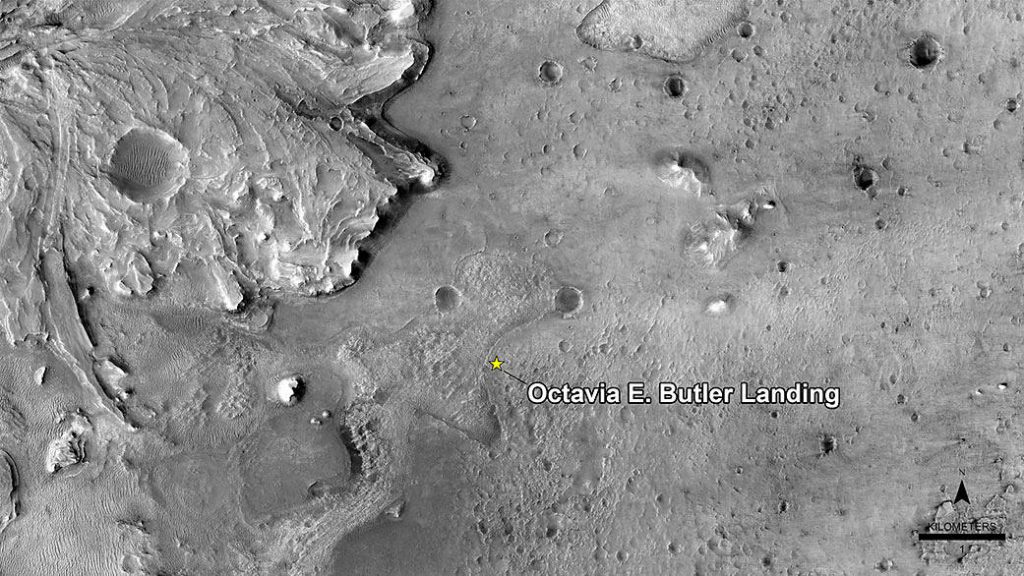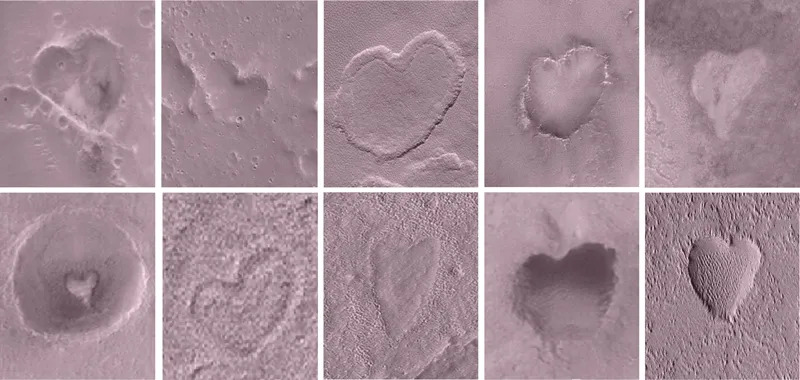Mars may be named after the god of war, but it seems more like a sappy romantic. NASA’s Mars Global Surveyor spacecraft spotted these hearts on the Martian surface throughout its time in orbit. All of them are natural formations, but let’s just go ahead and interpret them as love notes from the red planet. Image credit. NASA/JPL/Malin Space Science Systems.
Tag Archives: Mars
Curiosity discovers pure sulfur rocks, continues to explore Mount Sharp on Mars
From the JPL, with thanks to Alexis for the tip.
https://www.jpl.nasa.gov/news/nasas-curiosity-rover-discovers-a-surprise-in-a-martian-rock
Curiosity discovers pure sulfur rocks, continues to explore Mount Sharp on Mars
Among several recent findings, the rover has found rocks made of pure sulfur — a first on the Red Planet.
Scientists were stunned on May 30 when a rock that NASA’s Curiosity Mars rover drove over cracked open to reveal something never seen before on the Red Planet: yellow sulfur crystals.
Since October 2023, the rover has been exploring a region of Mars rich with sulfates, a kind of salt that contains sulfur and forms as water evaporates. But where past detections have been of sulfur-based minerals — in other words, a mix of sulfur and other materials — the rock Curiosity recently cracked open is made of elemental, or pure, sulfur. It isn’t clear what relationship, if any, the elemental sulfur has to other sulfur-based minerals in the area.
While people associate sulfur with the odor from rotten eggs (the result of hydrogen sulfide gas), elemental sulfur is odorless. It forms in only a narrow range of conditions that scientists haven’t associated with the history of this location. And Curiosity found a lot of it — an entire field of bright rocks that look similar to the one the rover crushed.
Pan around this 360-degree video to explore Gediz Vallis channel, the location where NASA’s Curiosity Mars rover discovered sulfur crystals and drilled its 41st rock sample. The images that make up this mosaic were captured by the rover’s MastCam in June.
Credit: NASA/JPL-Caltech/MSSS
“Finding a field of stones made of pure sulfur is like finding an oasis in the desert,” said Curiosity’s project scientist, Ashwin Vasavada of NASA’s Jet Propulsion Laboratory in Southern California. “It shouldn’t be there, so now we have to explain it. Discovering strange and unexpected things is what makes planetary exploration so exciting.”
It’s one of several discoveries Curiosity has made while off-roading within Gediz Vallis channel, a groove that winds down part of the 3-mile-tall (5-kilometer-tall) Mount Sharp, the base of which the rover has been ascending since 2014. Each layer of the mountain represents a different period of Martian history. Curiosity’s mission is to study where and when the planet’s ancient terrain could have provided the nutrients needed for microbial life, if any ever formed on Mars.
Rover Landing Site Named for Butler
Rover Landing Site Named for Butler

NASA has named the landing site of the Mars 2020 Perseverance rover after SF author Octavia E. Butler (1947-2006). The rover was launched from Cape Canaveral FL on July 30, 2020 and landed in Jezero Crater, Mars on February 18, 2021. The mission will spend at least one Mars year (two Earth years) exploring the landing site region.
For more information, see NASA’s website.
Missions to Mars
Mars, the planet most likely to stir the blood of an SF fan!
And it’s a real busy place. Three nations took advantage of the close orbit of Mars in 2020 to send missions to the Red Planet. NASA’s mission to look for signs of life is already underway. https://www.nasa.gov
The press is covering the Perseverance mission, almost to the exclusion of the other two which are equally interesting.
The Chinese Satellite is in parking orbit today. It has a lovely name taken from the title of an ancient poem: Tianwen, which means Quest for Heavenly Truth. It will also be looking for water and signs of life. https://www.ctvnews.ca/sci-tech/china-s-mars-craft-enters-parking-orbit-before-landing-rover-1.5321743
The United Arab Emirates has a satellite in orbit since the ninth of February. It’s called Hope, and will be focussed on learning more about the atmosphere, and possibly understanding how the climate changed.
It’s amazing that all three launched in 2020 have succeeded, so far. There have been more failures than successes over the years.
Adding to the drama, there are probably 8 derelict satellites in orbit also, and their exact positions are not known.
Ham radio signals from Mars
https://spaceweather.com
https://www.spaceweatheralerts.com
HAM RADIO SIGNALS FROM MARS: Ham radio operators are doing something that until recently only big Deep Space Networks could do. They’re listening to radio signals from Mars. The “loud and audible” transmissions come from spacecraft orbiting the Red Planet. Some hams are hoping to detect NASA’s Perseverance rover as it touches down later this week. Find out how it’s done on today’s edition of Spaceweather.com.
3D IMAGES OF MARS
Warning: Mars is about to leap out of your computer screen.
![[]](https://gallery.mailchimp.com/0c5fce34d5ca05f64a13d085d/images/2c55767c-48ac-43a9-a87d-c9319458f7a9.jpg)
Space Weather News for Nov. 17, 2020
https://spaceweather.com
https://www.spaceweatheralerts.com
3D IMAGES OF MARS: Warning: Mars is about to leap out of your computer screen. European astronomers have just released some of the best photos of Mars ever taken from Earth. They’ve assembled the images into a crazy-good 3D animation of the Red Planet spinning on its axis. See for yourself on today’s edition of Spaceweather.com.
![[]](https://mcusercontent.com/0c5fce34d5ca05f64a13d085d/images/9ac4afe4-8347-4ea7-812a-313427f202be.jpg)
Above: This photo of Mars taken last month from Pic du Midi is one of many used to create a best-ever 3D animation of the Red Planet.
A DARK STREAK JUST APPEARED ON MARS
https://spaceweather.com
https://www.spaceweatheralerts.com
A DARK STREAK JUST APPEARED ON MARS: Amateur astronomers are monitoring something new on Mars. A dark streak has just appeared near one of the Red Planet’s giant extinct volcanoes, Arsia Mons. It appears to be a cloud, but the jury’s still out. Visit today’s edition of Spaceweather.com for images and more information.
![[]](https://mcusercontent.com/0c5fce34d5ca05f64a13d085d/images/dec21ae4-4502-45a6-a93c-26aea05d25ee.jpg)
Above: A 600 km long dark streak, observed by amateur astronomers (left) and projected onto an image from Mars Orbiter (right). Credit: Maximilian Teodorescu.
A signal from Mars
This week, an amateur radio operator in British Columbia picked up a signal from Mars
![[]](https://gallery.mailchimp.com/0c5fce34d5ca05f64a13d085d/images/2c55767c-48ac-43a9-a87d-c9319458f7a9.jpg)
Space Weather News for Oct. 6, 2020
https://spaceweather.com
https://www.spaceweatheralerts.com
RADIO SIGNALS FROM MARS: This week, an amateur radio operator in British Columbia picked up a radio signal … from Mars. It came from NASA’s Mars Reconnaissance Orbiter flying just 274 km above the Red Planet’s surface. Such a detection is possible because, right now, Mars is unusually close to Earth. Want to hear what it sounds like? Visit today’s edition of Spaceweather.com.
Aurora alerts: Sign up for Space Weather Alerts and receive a text message when auroras appear in your area.
![[]](https://mcusercontent.com/0c5fce34d5ca05f64a13d085d/images/304c83a3-4f34-4be0-bfe1-c1bccb43aa9b.jpg)
MARS IS NOW BRIGHTER THAN SIRIUS
https://spaceweather.com
https://www.spaceweatheralerts.com
MARS IS NOW BRIGHTER THAN SIRIUS: Mars is approaching Earth for one of its best apparitions since 2003. Earlier this week, the Red Planet crossed an important threshold. It is now brighter than Sirius, the brightest star in the sky. Amateur astronomers are capturing amazing images of Mars using ordinary telescopes, and the best is yet to come. Visit Spaceweather.com for observing tips.
Aurora alerts: Sign up for Space Weather Alerts and receive a text message when auroras appear in your area.
![[]](https://mcusercontent.com/0c5fce34d5ca05f64a13d085d/images/2d2979f5-1c01-4f5f-8f04-b48f06d71f0a.gif)
Above: One hour of Mars on Aug. 18, 2020, as seen through a 14-inch telescope. Credit: Maximilian Teodorescu of Magurele, Romania
APPROACHING MARS: By the time you finish reading this sentence, you’ll be 40 km closer to Mars.
Earth and Mars are converging for a close encounter this Fall, one of the best since 2003, and their separation is rapidly shrinking–negative 8 km/s as of Aug. 21st. You are literally approaching the Red Planet. Just this week the brightness of Mars surpassed that of Sirius, the brightest star in the sky. Suddenly, Mars is almost bright enough to see in daylight and an easy target for backyard telescopes.
The best is yet to come. By the night of closest approach on Oct. 6th (0.4149 AU), Mars will more than double in brightness again, outshining everything in the night sky except Venus and the Moon. Throughout this apparition, the south pole will remain tilted toward Earth, giving observers a good view of the breakup of the ice cap as Martian spring turns into summer.
Perseverance–Launching for Mars
https://mars.nasa.gov/mars2020/
Mission: To seek signs of ancient life and collect rock and soil samples for possible return to Earth.
Quick Facts


